Jean Baptiste Vuillaume (1798 – 1875), luthier de son état, a paradoxalement beaucoup apporté à l’archeterie française du XIXème. Inventeur de génie, il a créé de nombreux modèles dont l’archet à mèche interchangeable…
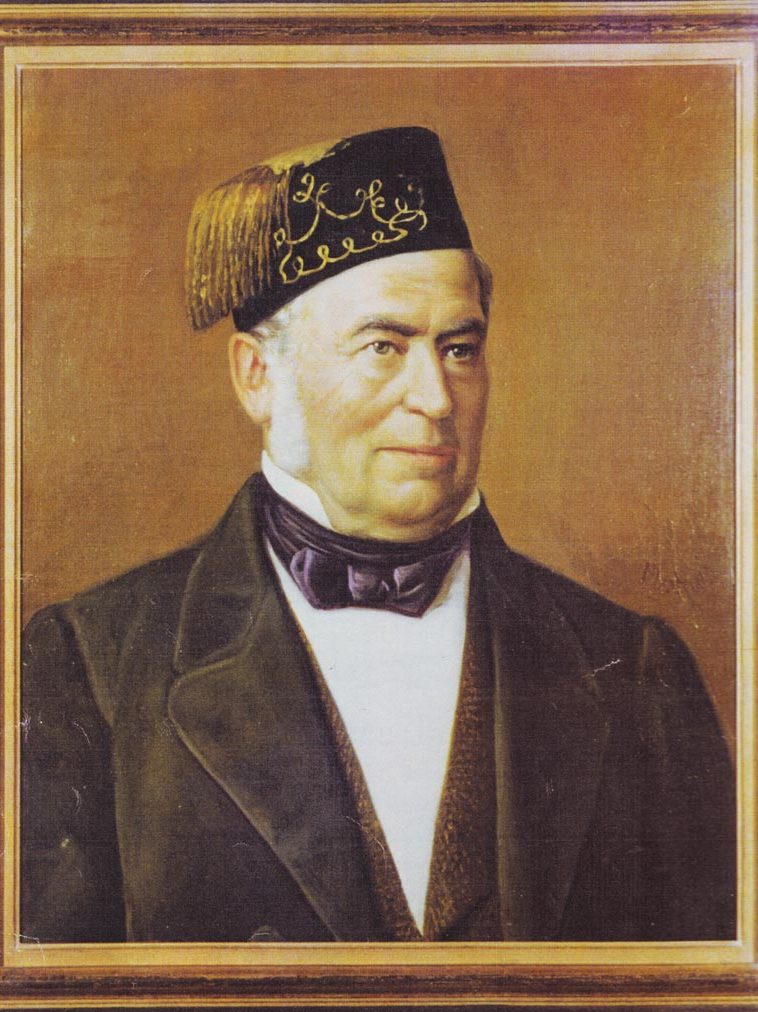
Jean-Baptiste Vuillaume travaille un temps pour François Chanot avant d’être embauché par Nicolas Antoine Lété, chez qui il réalise ses premiers violons et dont il devient l’associé en 1825.
Il s’installe à son propre compte à partir de 1827 au 46, rue des Petits Champs à Paris Ier, adresse que l’on retrouve inscrite sur la boîte de mèches de rechange.
Vuillaume s’intéresse très tôt aux archets et multiplie ses collaborations avec tous les plus grands archetiers français dont Jean Pierre Marie Persoit, Dominique Peccatte et Claude Joseph Fonclause pour ne citer qu’eux.
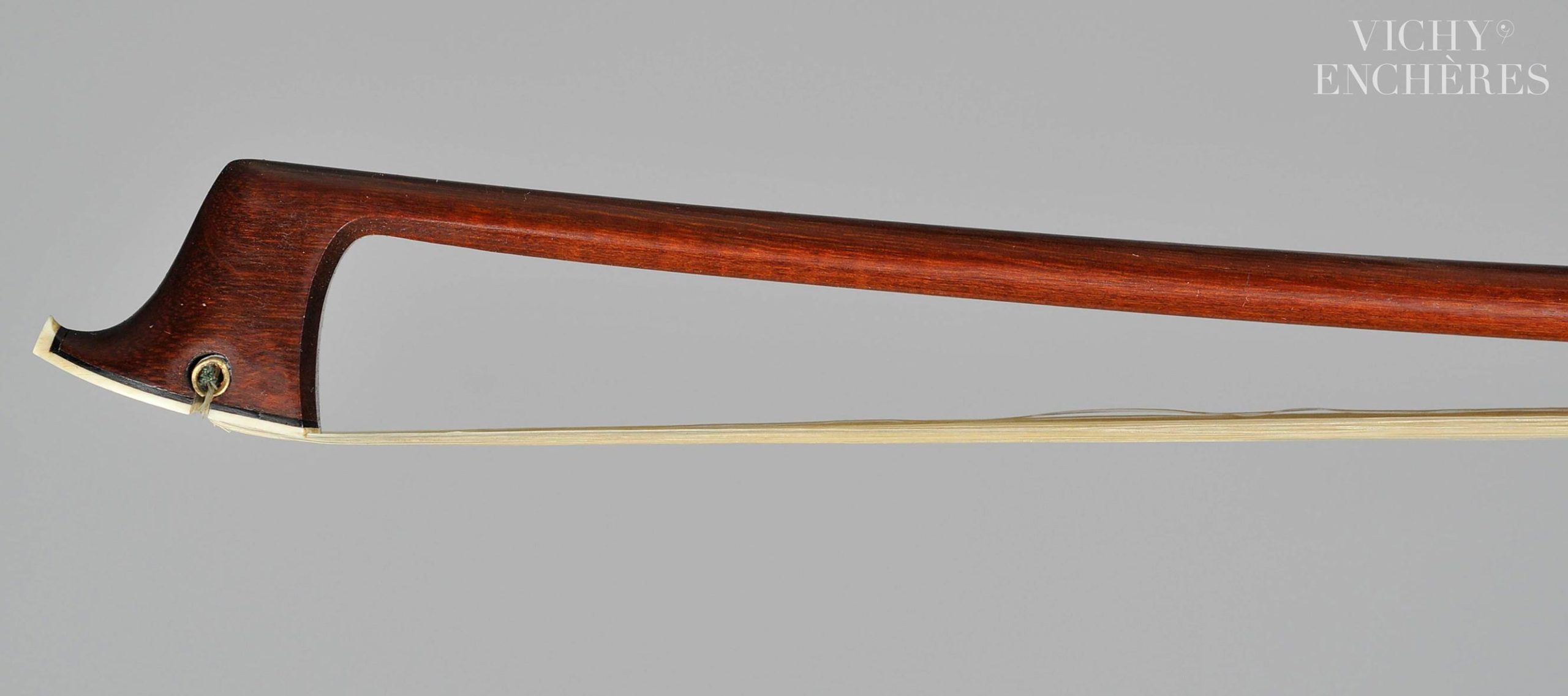
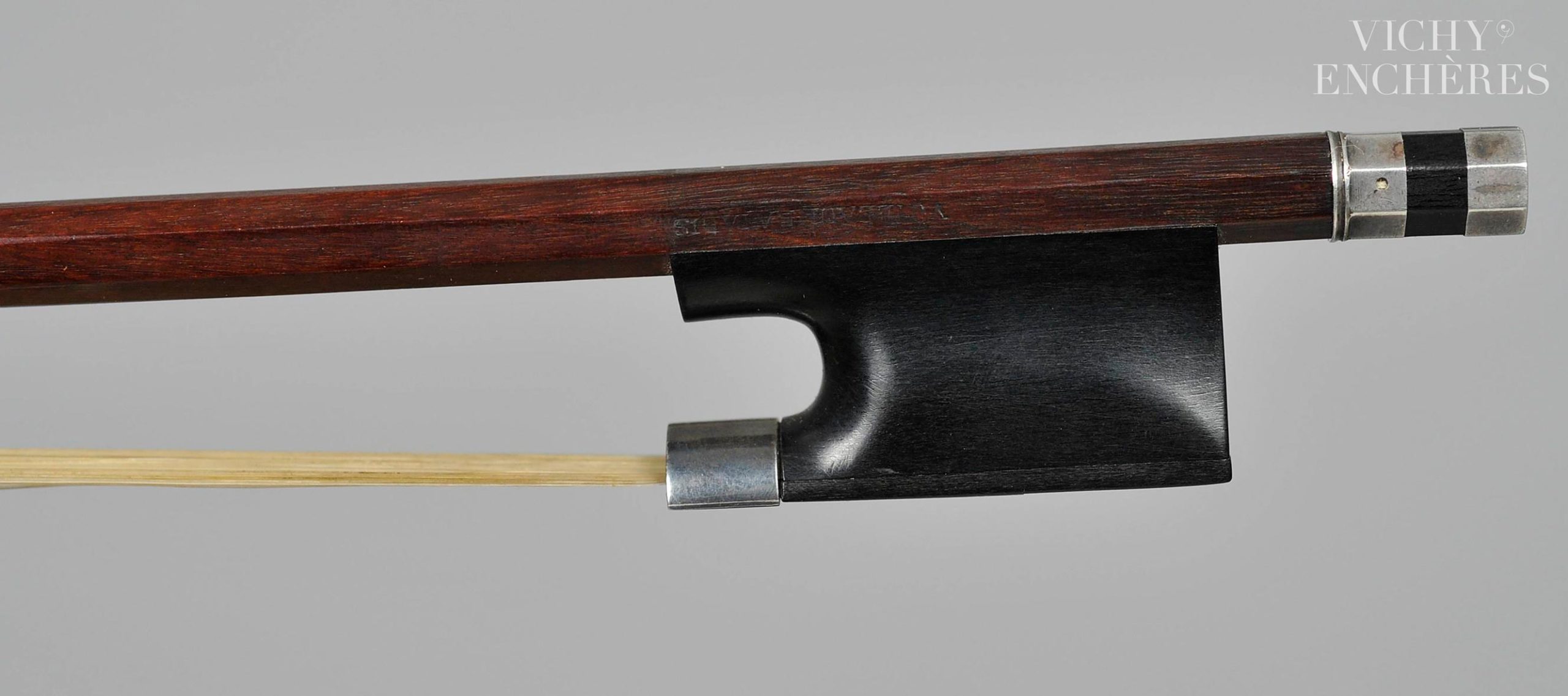
Jean Baptiste Vuillaume n’est pas, pour être tout à fait honnête, à l’origine de l’archet à mèche interchangeable. C’est l’atelier Pajeot qui en a l’idée originale. Mais c’est bien Vuillaume qui a su le développer de manière ingénieuse et le fabriquer.
Le 30 novembre 1835, il dépose même un brevet d’invention pour ce modèle, qu’il produira pendant 15 ans.
L’intérêt de ce système profite aux musiciens qui n’ont pas l’opportunité de se rendre fréquemment dans les grandes villes. Ils peuvent ainsi remécher eux-mêmes leur archet.
« L’archet est en effet vendu avec une note explicative dans une boîte contenant plusieurs mèches préparées, serties à leurs extrémités dans des tubes de cuivre qu’il suffit d’introduire dans une fente appropriée, au niveau de la plaque de tête et dans l’écrou du mécanisme de tension, au centre de la hausse collée sous la baguette. On découvre aisément cet écrou en démontant le passant et la base de la hausse qui s’emboîte sous le talon. »
« l’Archet » de Bernard Millant et Jean François Raffin, L’Archet Editions, 2000, tome II
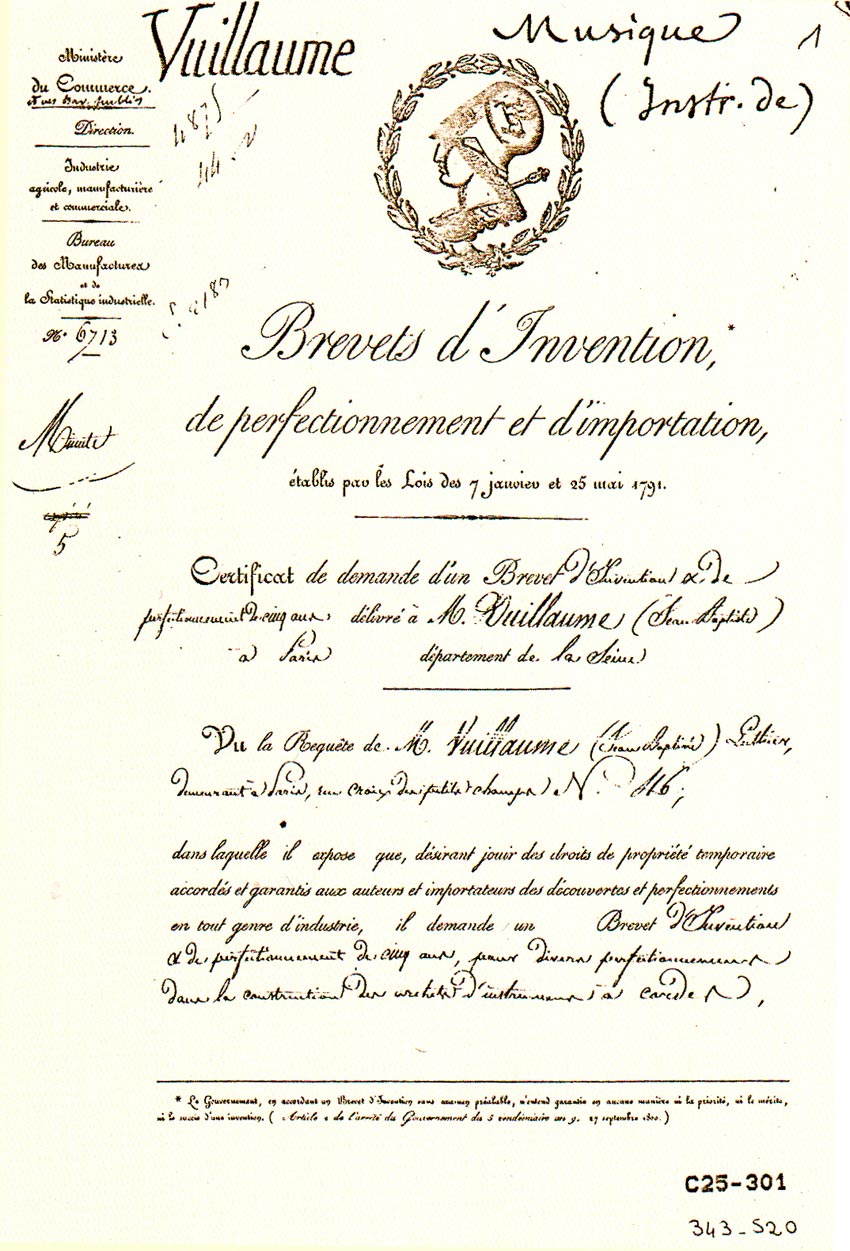
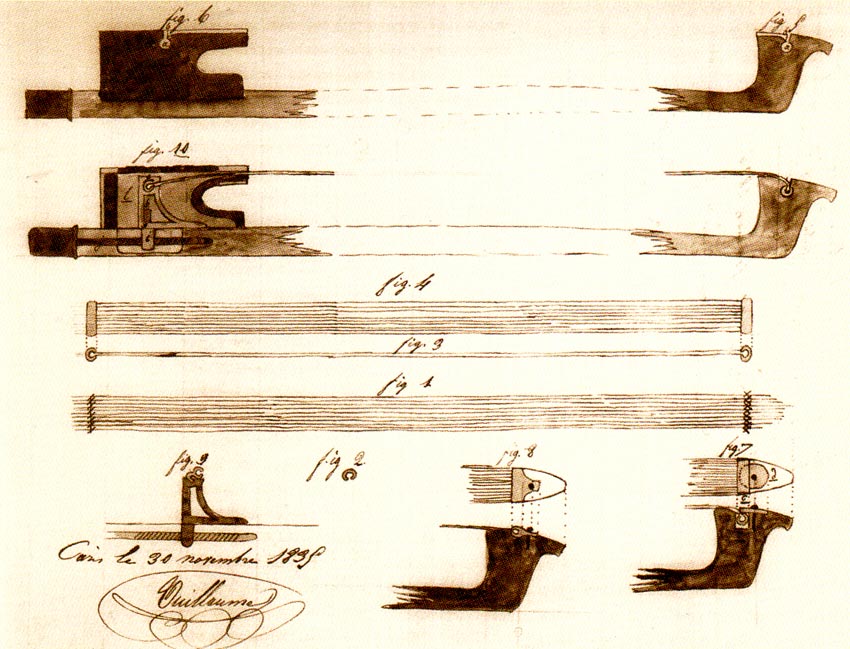
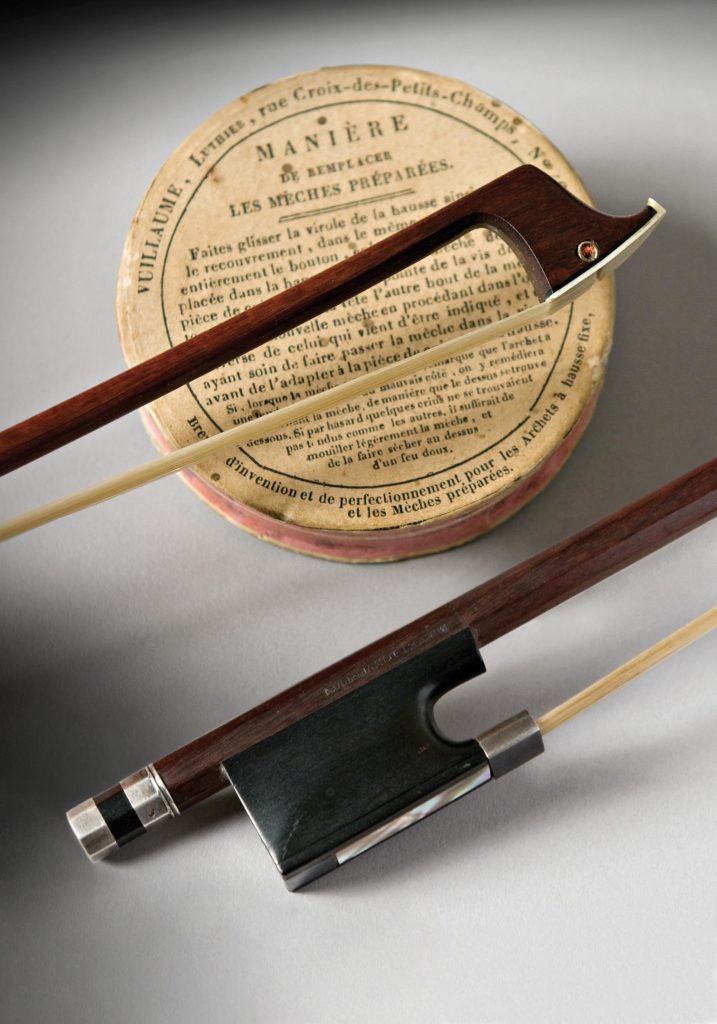
Manière de remplacer les mèches préparées:
Faites glisser la virole de la hausse ainsi que le recouvrement, dans le même sens ; dévissez entièrement le bouton, enlevez la pièce de cuivre placée dans la hausse, détachez la mèche de cette pièce de cuivre, et, avec la pointe de la vis du bouton, faites sortir de la tête l’autre bout de la mèche ; replacez la nouvelle mèche en procédant dans l’ordre inverse de celui qui vient d’être indiqué, et en ayant soin de faire passer la mèche dans la virole avant de l’adapter à la pièce de cuivre de la hausse. Si lorsque la mèche est placée, on remarque que l’archet a une tendance à gauchir du mauvais côté, on y remédiera en retournant la mèche, de manière que le dessus se trouve dessous. Si par hasard quelques crins ne se trouvaient pas tendus comme les autres, il suffirait de mouiller légèrement la mèche, et de la faire sécher au dessus d’un feu doux.
Brevet d’invention et de perfectionnement pour les Archets à hausse fixe et les Mèches préparées.
Vuillaume, Luthier, rue Croix-des-Petits-Champs, N° 46.
Prosper Colas, Claude Joseph Fonclause, Jean Grand-Adam, Joseph Henry, Charles Claude Husson, Nicolas Maire, Nicolas Maline, Jean Joseph Martin, Charles Peccatte, Dominique Peccatte, François Peccatte, Jean Pierre Marie Persoit, Justin Poirson, Pierre Simon, François Nicolas Voirin.
En 1851, Jean Baptiste Vuillaume est décoré de la Croix de la Légion d’Honneur. Il décède le 19 février 1875 d’une attaque d’apoplexie et est enterré au cimetière Montmartre à Paris.
Jean Baptiste Vuillaume (1798 – 1875), despite being primarily a violin maker, made significant contributions to French bow making in the 19th century. He was a genius inventor, and created many new models, including the bow with interchangeable hair.

Jean-Baptiste Vuillaume worked for François Chanot for a while before being hired by Nicolas Antoine Lété, where he made his first violins, and becoming his business partner in 1825. He set up on his own in 1827 at 46, rue des Petits Champs in the First district of Paris, which is the address that can be found on the box of spare hair.
Vuillaume took an early interest in bows and actively collaborated with all the greatest French bow makers of his time, including Jean Pierre Marie Persoit, Dominique Peccatte and Claude Joseph Fonclause to name a few.


Jean Baptiste Vuillaume did not have the original idea for the bow with interchangeable hair; the Pajeot workshop did. But it was Vuillaume who developed the idea ingeniously and who manufactured it. On 30 November 1835, he even filed a patent for this model, which he produced for 15 years. This system is of benefit to musicians who do not have the opportunity to travel regularly to major cities, as it allows them to rehair their bow themselves.
« The bow is indeed sold with an explanatory note in a box containing several prepared hair sets, held together at each end by copper tubes which can simply be inserted into the appropriate slots, one in the head plate and the other in the nut of the tension mechanism, glued under the stick in the middle of the frog. This nut can be accessed easily by removing the ferrule and the frog slide which fits into the small heel. »
« l’Archet » de Bernard Millant et Jean François Raffin, L’Archet Editions, 2000, tome II



Method for fitting the prepared hair sets:
Pull the ferrule of the frog as well as its pearl slide, in the same direction; completely unscrew the button, remove the copper part placed inside the frog, remove the hair from this copper part, and, with the tip of the button screw, push the other end of the hair out of the head; replace with a new set of hair by proceeding in the reverse order to that which has just been indicated, taking care to insert the hair through the ferrule before attaching it to the copper part of the frog. If, when the new hair is in place, the bow has a tendency to bend on the either side, this can be remedied by fitting the wick the other way around, so that the top is now facing out. If it happens that some hairs are not stretched as much as the others, one simply needs to slightly wet the hair, and dry it over a low heat.
Patent for the invention and improvement of bows with fixed frog and prepared hair sets.
Vuillaume, Luthier, rue Croix-des-Petits-Champs, No. 46
Prosper Colas, Claude Joseph Fonclause, Jean Grand-Adam, Joseph Henry, Charles Claude Husson, Nicolas Maire, Nicolas Maline, Jean Joseph Martin, Charles Peccatte, Dominique Peccatte, François Peccatte, Jean Pierre Marie Persoit, Justin Poirson, Pierre Simon, François Nicolas Voirin.
In 1851, Jean Baptiste Vuillaume was awarded the National Order of the Legion of Honour. He died on 19 February 1875 of a stroke and was buried in Montmartre cemetery in Paris.